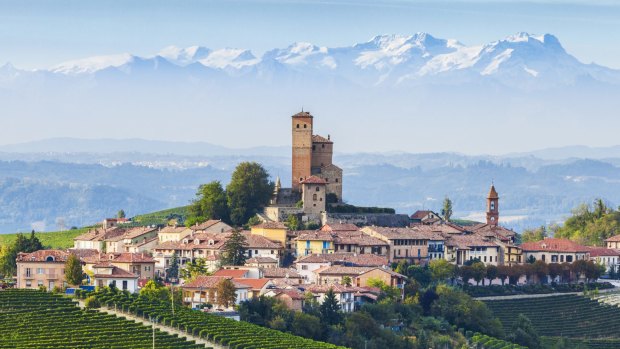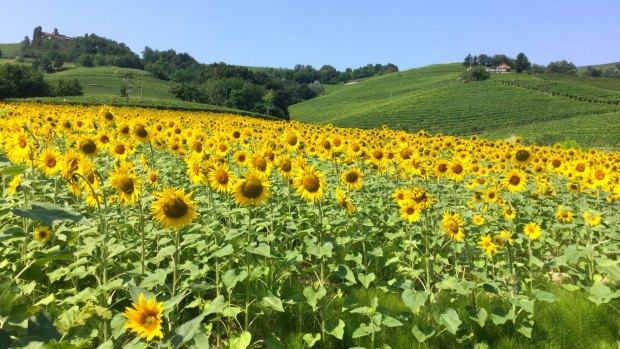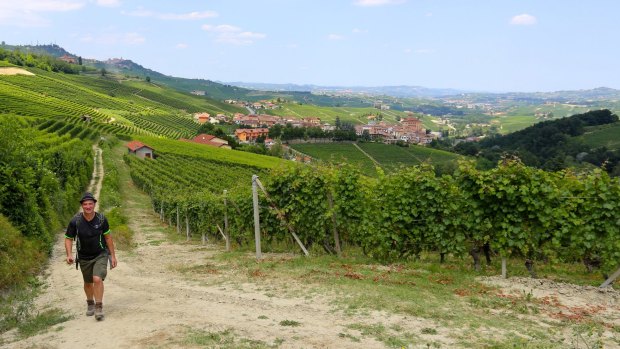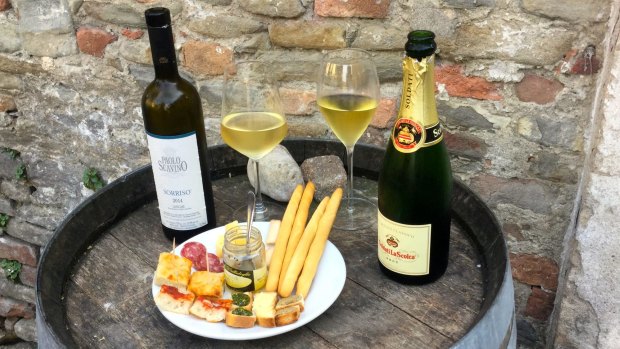This was published 8 years ago
Piedmont, Italy: Slow food movement and a trek through the Langue hills
By Daniel Scott

Serralunga d'Alba, a hill town in the Langhe, Piedmont, Italy, with the Alps behind.Credit: Damian Davies
It's 12.30pm on the third day of our trek through the Langue hills when we reach the tiny, circular village of Roddino.
Normally, most of its 390-odd villagers would be at lunch or having a siesta but today a crowd is gathered outside the central Chiesa di Santa Margarita.
The church bells are pealing, a shiny Volkswagen Beetle convertible awaits on the cobbled piazza below and, at the entrance to the church, is a huge red heart made of paper.

Scenery in Piedmont.Credit: Daniel Scott
As women totter in high heels on the church steps and men strut in brightly coloured pants, I want to dissolve into my sweat-drenched hiking gear.
Then, as the thump in my chest finally dulls, confetti spumes into the air and the newly married couple burst through the paper heart to rapturous acclaim.
It's been the toughest morning of our trek so far, up and down four high ridges, through orchards of hazelnut trees offering little respite from the blistering July sunshine.

Vineyards in Piedmont.Credit: Daniel Scott
Although we'd partly chosen this Hidden Italy trek, in the northern Piedmont region bounded by the Alps to the north and west because we'd assumed it would be cooler here than on walks further south, temperatures in the low 30s have become the norm.
I bolt down most of an icy two-litre bottle of aqua minerale before pouring the remainder over my head. My demure Danish walking companion Lene, hot but not bothered, smiles at me like the Mona Lisa before we go in search of a light lunch.
Behind the church is a large, unpromising wooden door beneath a sign that reads "Osteria da Gemma". We push open the door and climb the stairs to a room full of empty tables and chairs, where a man is washing glasses behind the bar.

Nieve wine bar fare.Credit: Daniel Scott
"Are you open?" I ask, in my rusty Italian learnt far too long ago in the Umbrian town of Perugia.
"Si, si, certo," he says, before ushering us to a table outside with views across the vineyards below.
With only five kilometres to go to today's endpoint of Serravale, we ask for water and wait to see what salads are on the menu.
The menu never arrives, and it transpires that at Osteria da Gemma you have one choice, the menu fixo, with or without wine.
So begins the most unexpected and irresistible of feasts. Opening with a veal tartare, minced with oil, lemon, salt and pepper, progressing through a Russian salad of eggs, peas and carrots and the local specialty of veal with tuna sauce, before not one but two fine pasta dishes.
By now, we've overcome feelings of overwhelm to polish off plates of tagliatelle with veal sausage and ravioli with spinach and veal sauce.
Then when the main courses, a bird-like rabbit dish and goat ribs with zucchini, are delivered, we giggle helplessly.
By the time a choice of three desserts – strudel, dark creme caramel or meringue – arrives, our "light lunch" has lasted two and a half hours and we are in raptures.
Well, what did we expect in the region where the "slow food" movement originated, in the 1980s? This is cooking with care, eating without haste and a philosophy that extends way beyond matters gastronomic.
A breakfast shake on the run? Forget it. A sandwich at your desk for lunch and a microwaved dinner? No way. Slow down and smell the rosemary. And white truffles and every other delicacy thrown at you by this region. Which, in my opinion, gives Tuscany a run for its money in terms of scenic good looks, enviable wines and produce and for its antediluvian hilltop towns, here unperturbed by hordes of visitors.
On this trek, departing and returning from the medieval town of Alba, an hour's drive south of Turin, and covering 82 kilometres of the Langue hills, we encounter no other trekkers and few other tourists.
It might be hot but there is a frisson to walking between rows of sun-smooched vines, their nebbiolo, barbera and moscato grapes visibly plumping in the swelter. Soon, come the autumn harvest, they will be plucked from their woody stems to make some of the planet's finest wine.
While we enjoy the region's wines along the way, particularly the powerful barolos and some less-heralded whites that drink perfectly on balmy summer evenings, this is no stumble between tastings. Our trek averages 13 kilometres a day.
Along the way we walk through a panorama barely distinguishable from how it must have appeared hundreds of years ago.
Ancient churches, castles and towers stand amidst villages, encircled by concentric medieval streets, at the crest of every defendable tor.
The region has long been highly valued due to its proximity to France, and its position on routes linking Milan and Turin with northern Europe. From the 16th century the House of Savoy exerted the major influence, remaining in power after Italian unification in 1860 until the Second World War.
Yet the surprise for us is walking, near the industrialised heart of northern Italy and its car-manufacturing capital, Turin, in such an antiquated and agrarian landscape.
Then again, the vineyards arrayed across the hills are as immaculately groomed as those Roddino wedding guests, sometimes appearing like a sweep of theatre seats rising from the valley below. It's only during the middle two days in the Upper Langue, that we walk out of the prime wine-growing area to pass through wilder forest.
We begin and end the trip in Alba, built on a Roman grid system, in the Tanaro river valley, where narrow medieval streets lead to piazzas presided over by bell towers and churches.
Famous for its white truffles, for wine and cheese from the surrounding hills and the fortress-like Ferrero chocolate factory, producing the much-loved Nutella spread, Alba is a gastronomic gathering place.
On our first in Alba, we dine at the Osteria del Arco, where the slow food movement was founded in 1986, delving into local delicacies like fried Cherasco snails, little parcels of pasta with cuttle fish, beans and olives and slow cooked rabbit, – and try Langue wine for the first time.
The next morning we make an unhurried start to our trek, following a track beside the Tanaro river while Claudio Botto, the young Deputy Mayor of nearby Montforte, transfers our luggage onto our next accommodation.
We then climb steeply to the village of Roddi, crowned by a 13th century bell tower and locked in a lunchtime yawn. We continue into the vineyards for the first time, picking up a dirt track between vines and blackberry bushes laden with fruit. Eventually we reach Verduno where we are billeted in the local castle.
A former residence of the Savoy royal family, the castello is the most characterful and old-world sumptuous accommodation of our trek, with giant, high-ceilinged rooms overlooking the Tanaro river valley.
The welcome at the family run hotel and restaurant could not be sweeter and our dinner in the sun-bathed gardens, featuring smoked trout, broad bean pasta, pea green risotto and quail wrapped in prosciutto, is perfect.
We reluctantly leave our royal lodgings the next morning, walking uphill through some of Italy's most renowned vineyards to one of its more famous towns, Barolo, cradled by fields of brilliant yellow sunflowers.
In Barolo, we spend two illuminating hours in the Wine Museum, its interactive displays clearly concocted by a wine-fuelled imagination. We jump on a bike and pedal through the wine-making cycle, view the history of wine from the Stone Age on in a series of dioramas, and see how wine has figured in art and cinema.
A simple sausage and basil tagliatelle in the square outside fortifies us for the remainder of the day's walk, amid rows of nebbiolo vines ranged with military precision along increasingly sharp inclines. We end at the imposing town of Montforte, where we are to spend the next two nights.
We have arrived in town for the beginning of the Montforte summer jazz festival and so after dinner make our way to an open-air concert by Californian band Los Lobos, in an amphitheatre-like square at the summit of town.
It's the next day that we face out stiffest challenge both in the morning's walking and that mammoth lunch in Roddino. Yet by the time we return to Montforte we have room for wine-tasting and a dinner, including gragnano pasta with gorgonzola and roast shank of pork, at the superb Case della Saracca.
Over the last three days we complete our circular trek to Alba, leaving the forest high above the Belbo river and returning to wine territory, now predominated by lighter barbaresco reds. We savour luxury at the four-star country hotel, the Villa d'Amelia and spend our penultimate night sample different vintages outside a wine bar in Neive, a hilltop settlement inhabited since Neolithic times.
Fortunately, each new wine we try is accompanied by free canapes, the latest of the welcome surprises that began with the feast at that "hidden Gemma" of an Osteria, in Roddino.
Nor is it only the scale of the meal that is memorable, but its astounding value: €27 (or $42) per person, for eight courses.
Yet, even that astonishment pales by comparison to the moment when I step onto the bathroom scales, back in Alba, to discover that, on this journey full of indulgences, I've managed to shed two kilograms marching through the Langue vineyards.
TRIP NOTES
FURTHER INFORMATION
GETTING THERE
British Airways flies daily from Sydney to London Heathrow, with connections to Turin from Gatwick. Economy fares start from $2181; see BA.com.
TOURING THERE
Hidden Italy's Piedmont self-guided walking tour starts from $1850 per person, including transfers to and from Turin,seven nights' accommodation (bed & breakfast), maps, detailed walking instructions background notes and daily baggage transfer. Pre-booked dinners cost extra. The trek is best done between May and early November. See hiddenitaly.com.au.
Daniel Scott travelled courtesy of Hidden Italy.
Sign up for the Traveller Deals newsletter
Get exclusive travel deals delivered straight to your inbox. Sign up now.